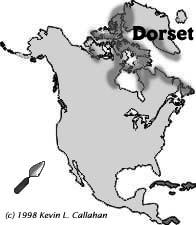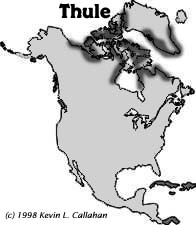Anth 3511 Professor Gibbon
Norton, Dorset, and Thule
| c.1000 BC-AD 800 |
Norton Tradition of the Western Arctic
a. Choris 1000-500 BC,
b. Norton 500 BC-AD 800
c. Iputiak AD 1-800 |
| c. 550 BC-AD 1100 |
Dorset Culture of the Eastern Arctic |
| c. 700 BC-AD 1800 |
Thule (Inuit/Eskimo) Tradition inAlaska |
| After c, AD 900 |
Thule Expansion Eastward |
1. Introduction. In contrast to the stable Archaic life-ways
of the interior Subarctic, radical cultural shifts occurred in
Far North coastal zones, first in the Bering Strait area and later
in the Eastern Arctic. These zones were occupied by the Norton
tradition in Alaska and the Dorset tradition eastward.
Both have roots in the Arctic Small Tool tradition and were
eclipsed by the neo-Eskimo Thule tradition after c. AD900.
Thule emerges historically as the Inuit (Eskimo).
2. The Norton Tradition of the Western Arctic (c. 1000 BC-AD
800).
A. The Norton tradition, which is divided into three cultures (Choris
1000-500 BC, Norton 500 BC-AD 800, Ipiutak
AD 1-800), is characterized by: (1) Major changes
in subsistence strategies: a more maritime focus, year round sea
mammal hunting both in open water and through winter ice, intensive
fishing; caribou and small mammal hunting remain important among
Choris and Norton people.
B. First definitive shift toward establishing permanent settlements
on the seacoast; substantial year-round semi-subterranean
houses; dense long-term occupation (hundreds of houses
occur at some sites, such as Point Hope).
C. An Arctic Small Tool tradition tool base except microblades
and the burin technology is gone; first pottery
vessels (fiber-tempered, stamped pottery from Asia) and stone
lamps for burning oil; toggling harpoons and polished
slate implements.
D. Of the three cultures, Choris is the most poorly known and
Norton the best because it occurs at many sites around the Alaska coast.
Ipiutak emerges in the far north of Alaska and is contemporary with
later Norton. Ipiutak lacks pottery, polished slate implements, and
oil lamps, but was a successful year round sea mammal hunting culture
with much permanent settlement, large coastal sites, and sophisticated,
elaborately decorated, harpoon heads.

3. The Dorset Culture of the Eastern Arctic (c. 550 BC-AD 1100)
A. For whatever reason, the Pre-Dorset culture evolved into the Dorset
culture during a period of heightened culture change in a cooler period.
Dorset was a remarkably homogeneous culture throughout its range.
B. Subsistence and domestic activity was much like the Pre-Dorset: The
winter spring season focused on sea mammal hunting (whales,
seals, walrus); in the summer and fall, caribou were hunted with
spears and fish (salmon, char) captured with fish harpoons
and compound leisters in rivers.
C. Rectangular, semi-subterranean winter houses, winter snow houses
(igloos), and round summer tends were built.
D. Tools include snow knives, blubber lamps, a ground slate industry,
distinctive harpoon head forms, sealing projectile points.
E. Dorset is famous for its elaborate and highly evolved artistic
tradition that includes carved wood, bone, and ivory depictions
of humans, spirit monsters, and animals; objects are of a magico-religious
nature; supernatural universe.
F. Dorset is famous also for what it lacks, including
harpoon floats, the maupok method of hunting seals
at breathing holes, dog sleds, cold-trap entrances for houses, bow and
arrows, throwing boards (they used simple lances and harpoons).

4. The Thule Tradition in Alaska (c.700 BC-AD 1800). Includes
all prehistoric Eskimo remains in Bering Strait after c. 700 BC,
fkom northern Alaska coast after c. Ad 800, from southern coasts
after c. AD 1000, and from Canada and Greenland
after c. AD 1000.
A. In Alaska, Thule tradition divided into an earlier Old Bering
Sea and later Punuk-Birnirk
cultures. By c. AD 1000, all the major items of historic Eskimo culture
existed throughout the Alaskan coast, including fully equipped kayaks,
umiaks, dog sleds, harpoon line floats, sunken houses with deep entrances,
heavy use of polished slate tools, pottery (thick and gravel tempered),
and a wide variety of specialized tools and weapons (e.g., components for
specialized arrows, darts, and spears for fish, birds, and different size
sea mammals; toggling and non-toggling harpoons; dart heads for land mammals;
snow goggles). An extensive organic inventory survives in the archaeological
record. These items revolutionized coastal life throughout the Arctic.
Some appear in the archaeological for the first time (kayaks, umiaks, dog
sleds, efficient toggling harpoons, harpoon line floats, harpoon mounted
ice picks). Objects of iron.
B. Thule was a highly specialized culture that emphasized
whale hunting where possible and winter ice hunting. Large
villages at favorable whaling locations organized economically
and ceremonially into whaling crews and whaleboat owning entrepreneurs
as in the historic period.
C. Their art a high point of all Eskimo art traditions.
Elaborate carved ivory objects. Changes through time
in this tradition seen mainly in differences in harpoon styles and art
motifs.
5. Thule Expansion Eastward. After c. AD 900, Thule traits and
people move southward to the Pacific coast, into the
Alaskan interior (e.g., Arctic Woodland culture), and across
northern Canada to Greenland. Probably related to a warm weather
cycle (Medieval Warm Period) that shifted pack ice northward
and changed path of sea-mammal migrations. Retreated after AD 1300 in cold
period.
A. Superior Thule technology out-competed Dorset people.
Thule emerges historically as the neo-Eskimo
Inuit (Dorset and earlier are Paleo-Eskimos).
B. Typical Thule equipment and life-ways but pottery replaced
by soapstone vessels. Hunters of seals, walrus,
and large whales. Used seal-skin covered kayak and more substantial
umiak for hunting and rapid transportation in summer; dog
sleds in winter. Used bow and arrow for caribou and
musk ox. Harpoons often propelled by throwing board. Three house
types.